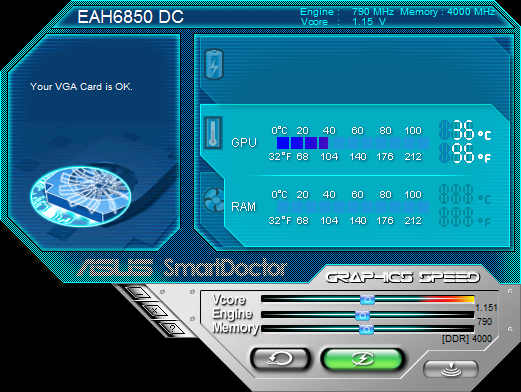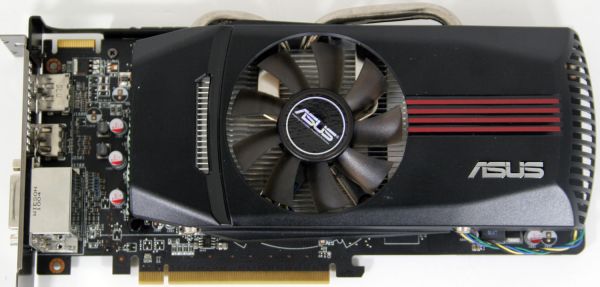AMD Radeon HD 6850 Overclocking Roundup: Asus, XFX, & MSI
by Ryan Smith on November 8, 2010 12:40 AM ESTMeet The Asus EAH6850
Our second card today is Asus’s first Radeon HD 6850, the EAH6850.The EAH6850 is the latest member in Asus’s Voltage Tweak subseries of cards, offering official voltage modification capabilities for overclocking through Asus’s SmartDoctor utility. It’s also the first overclocked card in today’s roundup, featuring a stock speed of 790MHz core and 1000MHz memory, a mere 15MHz over the 6850’s standard clocks. As a result the overclock is a token overclock at best - it’ll edge out stock-clocked cards in testing, but the difference is nothing to write home about.
In terms of design Asus has more or less completely thrown out the 6850 reference design for their own design. Starting with the PCB, Asus has gone with a custom PCB that runs a half-inch longer than the reference PCB, giving the EAH6850 a final length of 9.5”. With this extension Asus has moved the 6pin PCIe power socket to the top of the card, removing the need for additional clearance behind the card and in the process making the power socket much more accessible. Notably there’s a spot for a second power socket, and given the longer length of the card we wouldn’t be surprised if Asus ultimately released a 6870 using this PCB.
Meanwhile the component selection on the card is the usual mix of solid state capacitors and chokes. We haven’t been able to identify the VRM components in use, but we believe Asus is using a different VRM arrangement than on the reference 6850. The card also features a metal spine running down most the length of the card, providing the extra rigidity that a longer card requires and preventing it from significantly flexing.
Attached to the top of the card is the now customary Asus DirectCU cooler, Asus’s highly effective cooler which we have seen on a number of Asus cards in the past. This open-ended cooler uses a pair of aluminum heatpipes attached to a copper baseplate to transfer heat to the card’s aluminum heatsink, which runs roughly 2/3rds the length of the card. Embedded in the middle of the heatsink is the 70mm “dustproof” fan, and a partial shroud keeps airflow directed out the front and the rear of the card. Meanwhile the MOSFETs serving as part of the VRM circuitry have their own heatsink attached through springloaded clips, with airflow coming off of the fan keeping this second heatsink cool.
As is the case with the other partner cards in today’s roundup, Asus has ditched AMD’s 6800 series Eyefinity port configuration in favor of the 5800 series Eyefinity port configuration. This means the card has two DVI ports and the HDMI port along with one full-size DisplayPort, allowing the card to drive up to 5 monitors through a DP hub.

Because this is a Voltage Tweak card, Asus’s software plays an important role here by providing control for the card’s voltage modification capabilities. SmartDoctor has not changed since the last time we’ve seen it, providing a functionally competent but ultimately second-rate overclocking experience, as SmartDoctor lacks meaningful monitoring capabilities. Truth be told, the latest betas of MSI’s Afterburner software are able to program the EAH6850’s VRM controller, meaning there’s no practical reason to use SmartDoctor as the superior Afterburner is available.

As for pack-in items, Asus includes their usual collection for an AMD card: a quick-start manual, driver/utility CD, molex-to-PCIe power adaptor, short CrossFire bridge, a pleather CD binder, and a DVI-to-VGA dongle. Which on that note we had a chance to talk to Asus’s video card product manager last week and asked about the VGA dongle – it turns out that while VGA is largely dead & buried in North America, it’s alive and well in the Asia-Pacific region. Asus is simply packing their cards the same way in all regions, which means they all come with the VGA dongle.
Finally, the EAH6850 comes with Asus’s standard 3 year video card warranty. EAH6850 can be found for around $185, putting it at a $5 premium over AMD’s MSRP.


















93 Comments
View All Comments
tech6 - Monday, November 8, 2010 - link
Nice work Ryan.Let's all turn it down a notch about the 460 OC cards. This was never an issue and it still isn't. A number of available cards are chosen for comparison purposes but you can never include all possible variations. So those that are seeing some sort of conspiracy that has Anand taking bags of cash from a vendor in return for leaving out some card in his comparisons - it's time to take off you foil hats and come out from your basements. AT is an excellent and thorough tech review site and to throw out unsubstantiated charges of bias is just a cheap shot. If you have some sort of persuasive proof to contrary then please share it with the rest of us.
silverblue - Monday, November 8, 2010 - link
...it may be better to just compare the 6870 and its OCed variants to the best 460s around in a separate article. It's obvious (at least, to me) that in terms of performance, the OCed 6850s cannot match the 460 FTW and that the true competition would be the OCed 6870. In terms of power and temperature, the 6850 will win, but that's not of much concern when people want the fastest card.Veroxious - Monday, November 8, 2010 - link
Well I guess it's a case of damned if you do and damned if you don't..... IMO you should have included the superclocked EVGA GTX460 (focusing the article on OC results) as it would then be an apples to apples comparison. If one does refer back to the 6850/6870 article you will see that the 2 best overclocking cards (Asus and more so MSI) are neck and neck with the EVGA GTX460 FTW. So buying any of these cards would be an excellent buy.The DIFFERENCE is while the EVGA is arguably a limited version/best case scenario for the GTX 460 it costs $240. There is no price for the MSI card but the Asus card is $185 (out of stock currently on Newegg). As you can see in the article ALL the 6850 cards could hit 940Mhz on stock volts.
So you have a 185$ card that will give you the performance of a $240 card? No wonder there is no stock. At this price ($55 less) it gives the term "value for your money" real meaning. Can I have 2 please?
El_Capitan - Monday, November 8, 2010 - link
I'm sorry, but the EVGA GTX 460 1GB FTW isn't the best overclocking GTX 460 1GB card. It may be the best factory overclocked card, but the winner goes to:1. ASUS from $199.99 to $219.99 where available, hitting 1015MHz core clock.
2. MSI Hawk from $189.99 to $199.99 where available, hitting 960MHz core clock.
Comparing those prices to any of this review's HD 6850 cards that range from $184.99 to $189.00 plus shipping, the prices are equal.
Stuka87 - Monday, November 8, 2010 - link
Am I the only one who is not seeing *ANY* XFX scores on the benchmarks page?None of the graphs have it there??
Lazlo Panaflex - Monday, November 8, 2010 - link
I'm not seeing them either...WTH?Ryan Smith - Monday, November 8, 2010 - link
The XFX is stock-clocked, and when overclocked all of our cards reach common clocks. So we don't break out the scores separately.rpmrush - Monday, November 8, 2010 - link
I love the in-depth vid card reviews here. I really wanna c the custom cooled 6870 cards. I'm waiting to pull the trigger on the one that is quietest with decent overclocking head room.danielkza - Monday, November 8, 2010 - link
At page 8:"All of the cards could hit 850MHz core at stock clocks"
Didn't you mean:
"All of the cards could hit 850MHz core at stock voltages"
tomoyo - Monday, November 8, 2010 - link
It's funny to me that it'll seem like our wants are flipflopping, but the issue is pretty clear.An article about a brand new video card that isn't overclocked, should be compared against the same type of video card.
An article about overclocked video cards should be compared against overclocked video cards of the same market.
Simply put, you unfortunately made the wrong mistake both times, but at least this issue is pretty easy to correct. I hope you also add overclocked GTX 460 results into this one as an update, it does make sense to. The issue originally was that you compared an overclocked GTX 460, but did not compare it to an overclocked Radeon 6850.